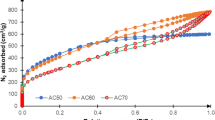Abstract
The cascade use of bamboo as the raw material for high-value products, that is, the production of xylo-oligosaccharide and the preparation of activated carbon for EDLC electrode, was proposed as an economically effective use of bamboo in this study. Xylo-oligosaccharides, such as xylobiose and xylotriose, were successfully produced from bamboo in a water solution by a hot compressed water process. The solid residue of bamboo after the treatment of the hot compressed water was carbonized at 400–800 °C, then activated with KOH. The KOH activation was effective for the preparation of activated carbon having a high BET specific surface area of ca. 2600 m2 g−1 from the solid residue. The amount of ash drastically decreased by the hot compressed water treatment, which should be an advantage as the precursor for EDLC electrodes. The capacitance values measured in a 1 M H2SO4 aqueous solution of the activated carbon derived from the solid residue compared well with those from the bamboo.









Similar content being viewed by others
References
H. Ando, H. Ohba, T. Sakaki, K. Takamine, Y. Kamino, S. Moriwaki, R. Bakalova, Y. Uemura, Y. Hatate, Hot-compressed-water decomposed products from bamboo manifest a selective cytotoxicity against acute lymphoblastic leukemia cells. Toxicol. In Vitro 18, 765–771 (2004)
D. Gonzaleza, V. Santosa, J.C. Parajo, Manufacture of fibrous reinforcements for biocomposites and hemicellulosic oligomers from bamboo. Chem. Eng. J. 167, 278–287 (2011)
W. Gu, G. Yushin, Review of nanostructured carbon materials for electrochemical capacitor applications: advantages and limitations of activated carbon, carbide-derived carbon, zeolite-templated carbon, carbon aerogels, carbon nanotubes, onion-like carbon, and graphene. WIREs Energy Environ. 3, 424–473 (2014)
G.Z. Chen, Supercapacitor and supercapattery as emerging electrochemical energy stores. Int. Mater. Rev. 62, 173–202 (2017)
A. González, E. Goikolea, J.A. Barrena, R. Mysyk, Review on supercapacitors: technologies and materials. Renew. Sustain. Energy Rev. 58, 1189–1206 (2016)
Q. Wang, J. Yan, Z. Fan, Carbon materials for high volumetric performance supercapacitors: design, progress, challenges and opportunities. Energy Environ. Sci. 9, 729–762 (2016)
Z. Wu, L. Li, J. Yan, X. Zhang, Materials design and system construction for conventional and new-concept supercapacitors. Adv. Sci. 4, 1600382 (2017)
J. Wang, P. Nie, B. Ding, S. Dong, X. Hao, H. Dou, X. Zhang, Biomass derived carbon for energy storage devices. J. Mater. Chem. A. 5, 2411–2428 (2017)
P. Gonzalez-Garcia, T.A. Centeno, E. Urones-Garrote, D. Avila-Brande, L.C. Otero-Diaz, Microstructure and surface properties of lignocellulosic-based activated carbons. Appl. Surf. Sci. 265, 731–737 (2013)
H. Chena, D. Liu, Z. Shen, B. Bao, S. Zhao, L. Wu, Functional biomass carbons with hierarchical porous structure for supercapacitor electrode materials. Electrochim. Acta. 180, 241–251 (2015)
A.M. Abioye, F.N. Ani, Recent development in the production of activated carbon electrodes from agricultural waste biomass for supercapacitors: a review. Renew. Sustain. Energy Rev. 52, 1282–1293 (2015)
P. Kalyani, A. Anitha, Biomass carbon & its prospects in electrochemical energy systems. Int. J. Hydrogen Energy 38, 4034–4045 (2013)
J. Jiang, L. Zhang, X. Wang, N. Holm, K. Rajagopalan, F. Chen, S. Ma, Highly ordered macroporous woody biochar with ultra-high carbon content as supercapacitor electrodes. Electrochim. Acta 113, 481–489 (2013)
Y.-J. Kim, B.-J. Lee, H. Suezaki, T. Chino, Y. Abe, T. Yanagiura, K.C. Park, M. Endo, Preparation and characterization of bamboo-based activated carbons as electrode materials for electric double layer capacitors. Carbon 44, 1581–1616 (2006)
C.-S. Yang, Y.S. Jang, H.K. Jeong, Bamboo-based activated carbon for supercapacitor applications. Curr. Appl. Phys. 14, 1616–1620 (2014)
M. Fujishige, I. Yoshida, Y. Toya, Y. Banba, K. Oshida, Y. Tanaka, P. Dulyaseree, W. Wongwiriyapan, K. Takeuchi, Preparation of activated carbon from bamboo-cellulose fiber and its use for EDLC electrode material. J. Environ. Chem. Eng. 5, 1801–1808 (2017)
T. Tsubota, M. Morita, S. Kamimura, T. Ohno, Performance as electrode of electrical double layer capacitor of activated carbon prepared from bamboo using guanidine phosphate and CO2 activation., J. Porous Mater. (2017). https://doi.org/10.1007/s10934-017-0390-5
T. Tsubota, Y. Maguchi, S. Kamimura, T. Ohno, T. Yasuoka, H. Nishida, Catalytic graphitization for preparation of porous carbon material derived from bamboo precursor and performance as electrode of electrical double-layer capacitor. J. Electron. Mater. 44, 4933–4939 (2015)
N.A. Echeverry-Montoya, J.J. Prias-Barragan, L. Tirado-Mejia, C. Agudelo, G. Fonthal, H. Ariza-Calderon, Fabrication and electrical response of flexible supercapacitor based on activated carbon from bamboo. Phys. Status Solidi C. 14, 1600258 (2017)
X. Zhou, L. Li, S. Dong, X. Chen, P. Han, H. Xu, J. Yao, C. Shang, Z. Liu, G. Cui, A renewable bamboo carbon/polyaniline composite for a high-performance supercapacitor electrode material. J. Solid State Electrochem. 16, 877–882 (2012)
G. Zhang, H. Chen, W. Liu, D. Wang, Y. Wang, Bamboo chopsticks-derived porous carbon microtubes/flakes composites for supercapacitor electrodes. Mater. Lett. 185, 359–362 (2016)
Acknowledgements
This study was supported by JSPS KAKENHI Grant Number JP 17K06031. The authors are grateful for JSPS.
Author information
Authors and Affiliations
Corresponding author
Electronic supplementary material
Below is the link to the electronic supplementary material.
Rights and permissions
About this article
Cite this article
Tsubota, T., Ishimoto, K., Kumagai, S. et al. Cascade use of bamboo as raw material for several high value products: production of xylo-oligosaccharide and activated carbon for EDLC electrode from bamboo. J Porous Mater 25, 1541–1549 (2018). https://doi.org/10.1007/s10934-018-0567-6
Published:
Issue Date:
DOI: https://doi.org/10.1007/s10934-018-0567-6




